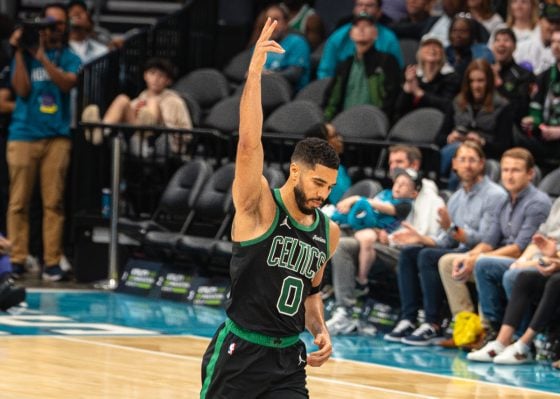Jaylen Brown has never been known as much of a facilitator. His lack of reputation in that regard is well earned. Brown has averaged a measly 2.7 assists per 36 minutes for his career, just barely topping his average of 2.4 turnovers per 36.
However, Brown has improved over the course of his seven years in the NBA. He’s tightened up his handle considerably from when he entered the league and adjusted meaningfully to the speed of the game. He’s much less prone to dribbling the ball off his leg or firing random passes out of bounds or to opponents because he’s simply hit the gas too hard without an actual lane to the hoop, but to say that Brown has been even an average creator for others would be an overstatement.
That reality may be beginning to shift.
In the month of March, Brown dished out 4.1 assists per game, by far the highest monthly mark of the season and one he achieved while reducing his turnover rate (2.5 per game). Leading up to March, Brown had posted a 1.05 assist/turnover ratio for the year. Over the course of the last month, that mark was 1.5.
Such growth may not seem monumental in an absolute sense, but it’s a nearly fifty percent improvement, and if it holds, it means Brown has transformed himself from a pretty bad facilitator to a fine one. A month is far too small a sample to claim such development, but the film shows a player that seems to have found a degree of simplicity that hasn’t always been present in Brown’s game.
The Celtics have been helping him get into advantageous spots. Very few of Brown’s March assists have required him to probe against an opposing defense as the lead ballhandler or operate in isolation for any reason other than to score. Most of his assists in the pick-and-roll come from pitchbacks to popping bigs.
There is nothing wrong with that. Brown is an outstanding individual scorer, with a lightning-fast first step and a quick trigger jumper that extends well beyond the three-point line. He’s at his best as a passer when he can leverage the threat he poses to open up easy passing lanes. Boston will put him in actions off the ball with other shooters to create chaos for opponents and make his reads very straightforward.
The Celtics can also leverage their spacing combined with Brown’s athleticism to suck in defenders when they utilize him as a roll man.
The same is true when Boston gets him the ball on the move virtually anywhere near the paint. Brown can literally take off for the rim at a moment’s notice, basically from the free throw line. Opponents need to honor that and typically surrender simple kickouts when they do.
Some of this may sound critical, but it’s meant as a major compliment. Brown simply isn’t the same level of passer as many of his teammates, but he’s so athletic and such a good scorer that he creates situations where less passing skill is needed. Marcus Smart, for example, could surely make virtually all the reads that Brown’s assists come from, but he can’t create the opportunity to do so by drawing in help defenders the way that Brown can just by making a step toward the hoop.
Brown and the Celtics deserve a ton of credit for finding ways to leverage what he does best to shore up an aspect of his game with clear limitations. Or at least they do if the progress he showed in March holds. A better passing, less turnover prone version of Brown would be a huge boost to the Boston offense heading into the postseason.






